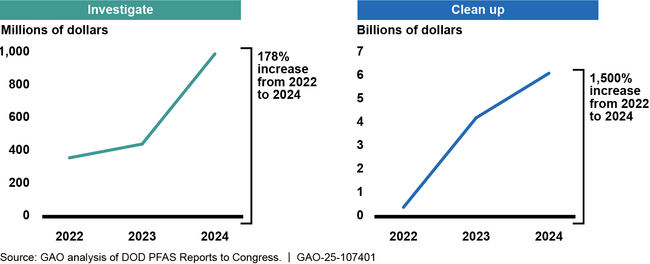Persistent Chemicals: DOD Needs to Provide Congress More Information on Costs Associated with Addressing PFAS [Reissued with revisions on Feb. 25, 2025]
Fast Facts
PFAS—known as "forever chemicals"—are found in many everyday objects. They can persist in water, soil, and air for decades and can cause health problems.
The Department of Defense has used firefighting foams that contained PFAS, on some of its installations, potentially exposing service members, their families, and nearby communities. It estimates investigation and cleanup costs could total over $9.3 billion in FY25 and beyond—tripling prior estimates.
DOD hasn't given Congress details on or examples of what's driving costs related to PFAS investigations and cleanup. We recommended it do so to better inform future funding decisions.

On February 25, 2025, GAO reissued this report to include comments from the Department of Defense in Appendix VII.
Highlights
What GAO Found
As of June 2024, the Department of Defense (DOD) had completed preliminary assessments and site inspections for per- and polyfluoroalkyl substances (PFAS) at nearly all 718 installations identified to have a potential PFAS release and had proceeded to the next step of the cleanup process at more than half. No locations have entered the long-term cleanup phases.
Department of Defense (DOD) Actions Related to Per- and Polyfluoroalkyl Substances (PFAS) at Current or Former Military Installations, as of June 2024

DOD efforts to investigate its PFAS releases have generally been thorough, and the department reports on the pace and cost of its efforts to Congress. DOD estimates that its future PFAS investigation and cleanup costs will total more than $9.3 billion in fiscal year 2025 and beyond. DOD's estimated future PFAS investigation and cleanup costs have more than tripled since 2022. GAO found that costs will continue to increase as DOD learns more about the extent of its PFAS releases—including the breadth and depth—through remedial investigations and determines what cleanup actions are required.
Department of Defense (DOD) Estimated Future Costs for the Investigation and Cleanup of Per- and Polyfluoroalkyl Substances (PFAS)by Fiscal Year

DOD has not communicated to Congress the full range of cost variables for future PFAS cleanup, referred to as total fiscal exposure. By including a detailed explanation and examples of changing key cost drivers for PFAS investigation and cleanup in its semi-annual cost report to Congress or other congressional reporting mechanism, Congress will be better equipped to make decisions regarding future funding for PFAS investigation and cleanup activities.
Why GAO Did This Study
DOD has spent $2.6 billion since 2017 addressing PFAS releases. PFAS are a large group of chemicals developed decades ago that can persist in the environment and cause adverse health effects. DOD's use of certain firefighting agents and other activities, such as metal plating, have led to PFAS releases from DOD installations, potentially exposing service members, their families, and surrounding communities. Investigating and cleaning up PFAS releases is an endeavor that could take DOD decades and billions of dollars to complete.
The National Defense Authorization Act for Fiscal Year 2024 includes a provision for GAO to review DOD's efforts to test and remediate PFAS contamination. This report (1) describes the status of DOD's efforts, and (2) assesses DOD's pace, thoroughness, and cost of its efforts, among other things. GAO analyzed DOD's PFAS-related reports to Congress, reviewed DOD and Environmental Protection Agency guidance and regulations, and interviewed officials.
Reissued with revisions on Feb. 25, 2025
On February 25, 2025, GAO reissued this report to include comments from the Department of Defense in Appendix VII.Recommendations
GAO recommends that DOD provide additional information to Congress on total fiscal exposure related to PFAS investigation and cleanup and a detailed explanation and examples of changing key cost drivers. DOD partially concurred and GAO modified the recommendation based on DOD's feedback.
Recommendations for Executive Action
| Agency Affected | Recommendation | Status |
|---|---|---|
| Department of Defense |
Priority Rec.
The Secretary of Defense should ensure that the Under Secretary of Defense for Acquisition and Sustainment includes in DOD's semiannual report to Congress on costs for investigating and cleaning up PFAS or other congressional reporting mechanism: (1) additional information regarding DOD's potential total fiscal exposure related to PFAS investigation and cleanup, including cost estimates at BRAC and other sites expected to be funded by DOD appropriations, and (2) a detailed explanation and examples of how changing assumptions about key cost drivers may affect future cost estimates. This additional information could be informed by a risk and uncertainty analyses of changing key cost drivers relating to PFAS investigation and cleanup. (Recommendation 1) |
When we confirm what actions the agency has taken in response to this recommendation, we will provide updated information.
|
